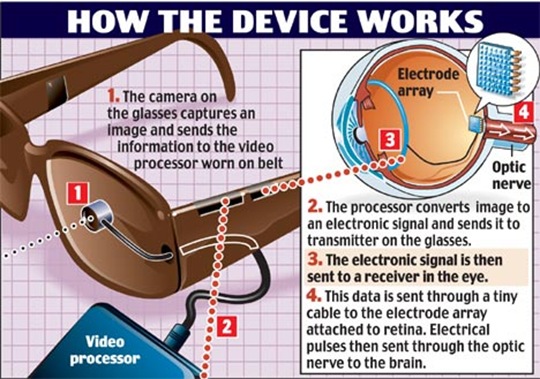
I bet we’ll start to see more and more of these types of stories in the next two to three years. Apparently two British men have received successful eye operations that have restored their sight. I saw another story on a 60 Minutes-type show (might have actually been 60 Minutes) about a guy in Colorado (maybe it was California) that got a similar operation and then wondered if he was better off blind. He’d already done a bunch of cool stuff like climbing mountains and riding horses and whatnot and he found that being able to see was a little bit overwhelming; he couldn’t tell his kids apart and his brain couldn’t differentiate between men and women so he had to re-learn “how” to see, basically, since he’d gone blind at a very young age.
But I digress. We’re talking about a different story now. This system uses a pair of glasses with a camera mounted on one of the lenses to record and convert imagery, which is sent as electrical impulses to the brain via the patient’s optic nerve.
It was developed in the US by a company in California called Second Sight and had been tested successfully on a handful of American patients before it was recently tested on British patients at Moorfields Eye Hospital in London.
The U.S. developers are now trying to shrink the camera so it will be small enough to be implanted into an eyeball.
They predict these pea-sized video cameras could be ready to be used in surgery in three to five years.
David Head, chief executive of the British Retinitis Pigmentosa Society, said: “These are significant advances and in conjunction with the advances being made in stem-cell therapy and gene therapy, make for really exciting times as we work to translate science into treatment.”
Professor John Marshall, chairman of the society’s medical advisory board, said: “It is very good news that devices have been developed and some individuals have had these inserted.
“However, the public should not run away with the idea that this is going to be routine surgery in the immediate future because there is an enormous amount to learn.”
That’s the ticket right there — the camera that gets implanted directly into the eyeball.